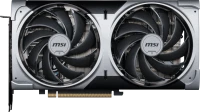EVGA Graphics Card Series: Gaming, XC, FTW, Watercooling and K|NGP|N
We independently test the products and technologies that we recommend.

EVGA Gaming: Middle class with excellent performance
Video cards of the EVGA Gaming line usually have the most basic equipment and belong to the middle class, where its main competitors are the Asus Dual, Gigabyte Gaming and MSI Gaming models. For the sake of economy, the manufacturer abandoned the integrated RGB backlight system, the back plate, factory overclocking and an enhanced power subsystem. At the same time, we are not talking about total savings on everything, rather, it is cutting off surpluses not at the sacrifice of productivity, noise or cooling qualities.
The results are appropriate. Video cards of the Turing generation adhere to NVIDIA specifications in terms of clock frequencies, but thanks to a powerful cooling system, in fact they produce a fairly high level of clock frequencies. For example, in performance tests, the EVGA GeForce RTX 2080 SUPER BLACK GAMING shows an average result and heats up moderately. The same applies to energy consumption and noise level. Therefore, the question "to take or not to take", as always, will depend on how much they will ask for the right card in the store.
EVGA XC: top-end graphics cards at a reasonable price
 |
Among all EVGA product lines, it is the XC that has the most blurry positioning. It seems like this is an elementary class, but under the XC flags, not so much the low-power GeForce RTX 1650 as the top-end variants of the RTX 2080 and RTX 3090 caliber come out. The design largely repeats the design of reference cards, the company's traditional ICX system is used as cooling, and price tags strive for maximum democracy. So it turns out that against the background of the rest of the brand's families, it is difficult to tell something really interesting about XC.
Take for example the new EVGA GeForce RTX 3070 XC3 Ultra. It can be safely called a typical representative of the NVIDIA Ampere line: triple cooler, black matte casing, small core overclocking, standard power consumption of 220 watts. The whole question is how it will show itself in the confrontation with other "non-top flagships" from MSI and Asus, and how much they will ask for it in the end.
EVGA FTW (For The Win): flagship models in the traditional sense
 |
Each manufacturer of video cards has its own flagship product line with bells and whistles to the maximum. Asus has ROG Strix, Gigabyte has Aorus, and Palit has GameRock. EVGA's positioning is more complicated: the top positions in the hierarchy are occupied by very expensive, first-class and technically complex K|NGP|N and WATERCOOLING models with water pumps, enhanced power and other enthusiast joys. And the family For The Win, which by all the laws of the genre is considered top, EVGA belongs more to the middle class.
For example, the new RTX 30XX line in the For The Win version uses a new ICX3 cooling system with 9 thermal sensors and three fans that can be controlled individually, and a massive backplate with a large contact surface area. All this stuff is seriously overclocked by the manufacturer, so for additional power, the cards are equipped with three 8-pin PCI-E connectors. As a result, in the RTX 3080 FTW3 ULTRA GAMING, the GPU frequency under load can reach the value of 1950 GHz, which at the moment makes it the fastest version of the GeForce RTX 3080 of all that went on sale.
EVGA WATERCOOLING: extremely serious water cooling
 |
Representatives of this family can boast of full-coverage water blocks, an enhanced power subsystem, an advanced iCX2 temperature monitoring system, as well as a good factory overclocking. However, the main thing here is a separate copper water block with a full Hydro Copper coating. Again, the project is designed for enthusiasts, so extreme acceleration for these babies is a familiar habitat. If most variations of the GeForce RTX 2080 are boosted to 1935 — 2000 MHz, then for the EVGA version it is not a problem to take the bar at 2145 – 2200 MHz without having to constantly look into the graphics card widget.
After the announcement of video cards on the NVIDIA Ampere core, the craftsmen from EVGA went into a frenzy and presented a whole bunch of water-cooled video cards, which formally belong to the same line of WATERCOOLING. Some of them are called Hydro Copper and are equipped with an unusual low water block (occupies only one slot) with a transparent lid in which the liquid overflows like a chameleon due to the address illumination. The other part belongs to the Hybrid sub-series with a more familiar closed-type liquid cooling system and a 240 mm radiator from the masters from Asetek. But we haven't reached the shops yet.
EVGA K|NGP|N: Damn powerful hybrid-cooled graphics cards created by Overclockers for Overclockers
 |
Overclocking a graphics card is like going to a rocking chair: many people just want to get in shape, while most people do not need it at all. And there are enthusiasts who are ready to train for hours and eat strictly by the hour in order to build up the coveted muscles gram by gram. EVGA K|NGP|N video cards are designed for such obsessive people, which were developed in collaboration with well-known overclockers Vince "k|ngp|n" Lucido and Ilya "TiN" Tsemenko.
These are flagship video cards even by the standards of other top-end lines from Asus, MSI or Gigabyte. Cards usually use a completely redesigned printed circuit board with a seriously modified power subsystem and a pack of auxiliary 8-pin connectors to connect additional power to this monster. According to the manufacturer, the GeForce RTX 2080 Ti K|NGP|N is capable of receiving more than 520 watts of energy. Hybrid cooling completes the picture. That is, both a traditional cooler and a three-section liquid cooling system will simultaneously cool the core and memory chips. All this technical splendor was created with one single goal ― to squeeze 110% even from the most powerful graphics card in the history of mankind. At least, this is the status claimed by the GeForce RTX 3090 K|NGP|N announced in September, but not yet on sale.
Articles, reviews, useful tips
All materials





























